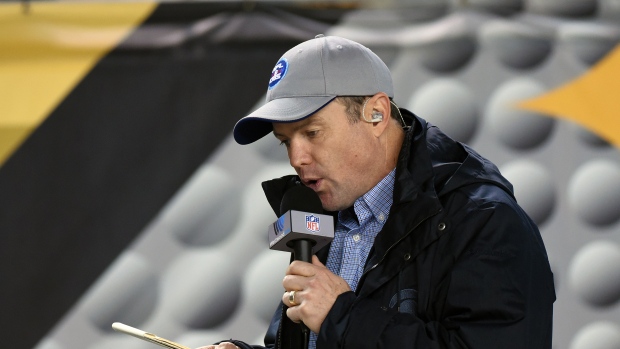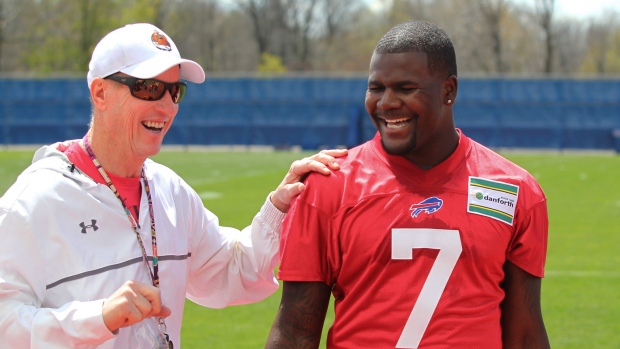May 9, 2016
Alzheimer's campaign hits close to home for Tasker
Buffalo Bills legend and CBS NFL analyst Steve Tasker recently sat down with TSN.ca to talk about his participation in "Huddle Up for New Alzheimer's Treatments," the risk of head injuries, watching his son play professionally and the Bills' latest draft class.
, TSN.ca Staff

Steve Tasker was a perfect choice to get involved with “Huddle Up for New Alzheimer's Treatments,” a campaign geared towards raising awareness in new treatments for the disease, but when his colleague at CBS, Solomon Wilcots asked him to link up with the group, he didn’t even realize why.
When he called and asked me to do it - because he knows I’m from the Toronto-Western New York area - he didn’t know that I have a family member, my mother-in-law, who’s afflicted with Alzheimer’s,” Tasker told TSN.ca. “So when he offered me the chance to help out in this way, I thought it was a great idea and jumped on board.”
The seven-time Pro Bowler recently sat down with TSN.ca ahead of the group’s May 25th engagement in Toronto.
The “Huddle Up” initiative comes at a time when football and the larger sports world is coming to terms with the realities of head injuries and the long-term effects that they can have on players. In March, Jeff Miller, the National Football League’s senior vice president for health and safety, finally acknowledged a link between the game and chronic traumatic encephalopathy (CTE). As for Alzheimer’s, the Mayo Clinic has identified a direct correlation between head trauma and developing the disease later in life.
For Tasker, the fact that more voices are being heard, more parties are becoming involved in talks represents a constructive move forward in monitoring head injuries, but he acknowledges that there is more work to be done.
“I think they’re both moving in the right direction,” Tasker says. “I think now, they’ve opened it up to the medical industry and given access to neutral parties to evaluate these guys, somebody who doesn’t have any skin in the game – both for the players and for the owners. I think that’s an enormous step and I think the fact that they’re ready to work together – and it’s such a no-brainer to do that – is huge. I think it will probably take some further steps beyond that, but we’ll have to wait and see what those are.”

The realities of a legacy of head trauma have hit home for Tasker with the famed Bills teams of the 1990s that reached four straight Super Bowls (1991 to 1994). Linebacker Darryl Talley’s battle with depression and suicidal thoughts has been well documented, while Hall of Fame running back Thurman Thomas revealed last month that a recent MRI showed the frontal lobe of his brain was “similar to someone who has fallen off the top of a house, on to the front of his head, or going through a windshield of a car several times.”
Tasker, who played for 12 seasons, says that concussion protocol existed in his playing days, but it was more empirical than anything else.
“They would bring you off, ask you how you were feeling and give you cursory questions about if you really hurt and a lot of times with concussions, you really don’t,” Tasker explains. “Then they start asking you questions and if you can answer all of the questions and you continue to feel good and feel cognitive, that was basically it. As soon as you felt like yourself or whatever, they’d allow you to go back in if you answered all of the questions correctly and you seemed to them to be normal.”
While the repercussions of head trauma were certainly not nearly as definitive during his playing days as they are right now, Tasker says that it only stood to reason that consequences could persist.
“When you look at the old guys and even back in my day, there’s always the odd hip replacement or knee replacement,” Tasker explains. “So you’ve gotta figure, there’s a chance you’re going to have some scar tissue down the road from the game you played.”
Even with better understanding and testing, one common element remains the same between today’s game and the one played in Tasker’s day and that’s fear – fear of missing time, fear of losing a spot and even the fear of confronting what a head injury could mean for a player’s life going forward.
“Every guy is different,” Tasker says. “Every guy reacts to it differently, every guy is affected by a concussion differently and they all have a different level of fear and a willingness to risk, but they all want to play very badly. Let’s face it, they’re paid very well to play this game that some do think is a risk.”
Though Tasker has been retired since 1997, his son, Luke, is currently a wide receiver for the Hamilton Tiger-Cats. While Tasker admits that there is some trepidation in watching his son out there, he feels that as a former athlete, he might be better equipped to handle what comes with having a family member in the game in a way that others are not.
“I don’t fear like his mother does and I don’t think she really fears it that much, either,” Tasker says of his son, who is heading into his fourth pro season. “I think it’s great that he loves what he’s doing, he’s good at it and he’s in a great spot. The Hamilton Tiger-Cats have treated him extremely well. He loves the team, the town, the league and so do we. For us, we probably have a different perspective than maybe somebody who’s never had a background in sports and suddenly has a son playing. For us, it’s been nothing but a positive.”

Tasker also sees a lot of positives in what his former team did at the NFL Draft earlier this month, but is quick to point out that the success or failure of this draft class won’t be truly evident until down the road. While Tasker is high on both of Shaq Lawson and Reggie Ragland and thinks they can both start immediately, he’s feels the Bills’ recent ability to find contributors later on in rounds has been a real asset.
“(Lawson and Ragland) are very good players and the Bills were stoked to get those guys when they did,” Tasker says. “But the guys further down, given the track record of (general manager) Doug Whaley and the coaching staff, they’ve had very good luck with guys down in the mid-to-late rounds. Look at Karlos Williams from last year, he was a huge surprise to a lot of people. Ronald Darby stepped right on the field. So if that continues to be the modus operandi of the front office and they find these guys that none of us really knows about, there’s no question that this is going to be a team that breaks that playoff drought.”
Of the players drafted by the team in the later rounds, no name piques interest more than Cardale Jones. Only a year removed from leading Ohio State to the inaugural College Football Playoff National Championship, Jones, taken in the fourth round, jumps into a quarterbacking picture in Buffalo that has seemingly been in constant flux over the last two decades following Jim Kelly’s retirement. Though Tyrod Taylor was named to the Pro Bowl in his first season with the Bills, Jones’s impact might be felt immediately by the Bills’ incumbent pivots, namely EJ Manuel.

“For those guys, EJ is different than Tyrod,” Tasker says. “Tyrod will probably welcome him with open arms, no problem. He’s going to mentor him and help him wherever he can because he’s an established player and he’s going nowhere because Cardale Jones was drafted. For EJ, not only was Cardale Jones drafted, but they also did not pick up his fifth-year option. So I think the writing is on the wall for EJ. EJ is a wonderful guy, who works hard at it and he’s been important for them and done a lot of good things in his career. He knows that the better he plays for the Buffalo Bills and the better he handles this situation, the better it will be for his next team and I believe he will continue to be in the NFL.”
With much of the league in the midst of rookie mini-camps, teams like the Miami Dolphins and Jacksonville Jaguars are shifting a greater focus to life and money skills than on-field drills when it comes to its freshmen this year. Tasker believes that initiatives like this are beneficial, but notes that many teams already expend resources in this direction.
“People would be shocked at how much orientation there is for these players coming in,” Tasker says. “They are given seminars, they’re given access to a lot of things that aren’t even mandatory and with the rookie camps, they do a lot of sit-down, classroom-type lectures. ‘Listen, don’t do this, don’t do that. Watch out for this, watch out for that.’”
The issue, for Tasker, is that the elite collegiate football player isn’t the typical adolescent. The culture shock can be palpable.
“The problem is, these guys are coming from college and they’re 18, 19, 20 or 22 years old and they come from backgrounds that are different from a lot of people’s,” Tasker explains. “On one hand, they’ve been very much entitled on the football side of things. They’re in a bit of a bubble and they’re usually the best player on whatever team they come from or certainly one of the better players and, if they’re not, they’re from an absolutely gifted or well-endowed program. But on the other hand, they come usually from backgrounds that aren’t affluent. They might be very poor. There could be problems with their family. And they’re now part of a culture that has seen them go from very poor to a very big program and now into the NFL.”
The difficulty, then, for teams becomes resonating with these kids and the realization that any and all efforts might be for naught with some.
“They’ve got some things they’re fighting against to try and get these guys acclimated to (being) a rich pro athlete,” Tasker says. “That’s an uphill battle and no matter how many times they do it or how much they do it, there’s going to be guys who fall through the cracks or just don’t want any part of it. So as much as you can give these guys advice, it’s up to them if they want to accept it.”
Tasker will be able to view whether or not this counsel takes root firsthand this when he begins his 19th season with CBS this fall.
